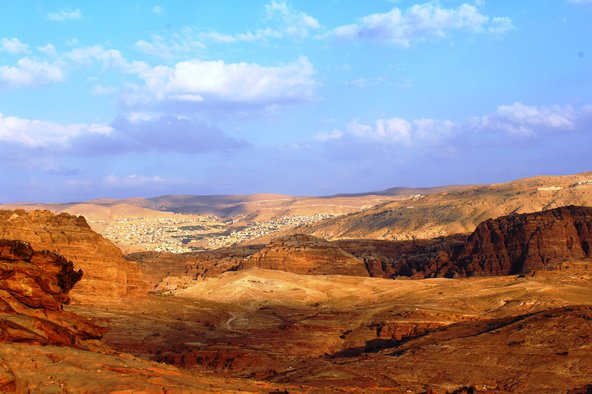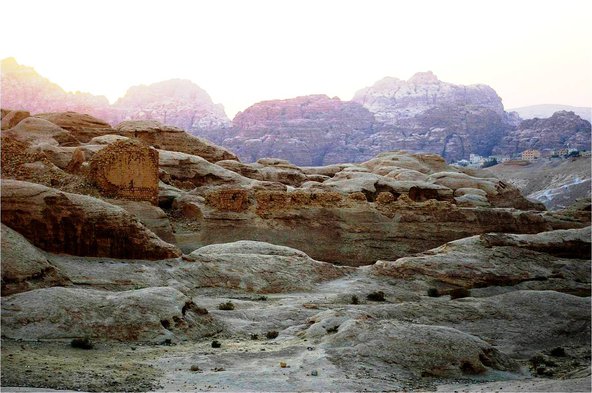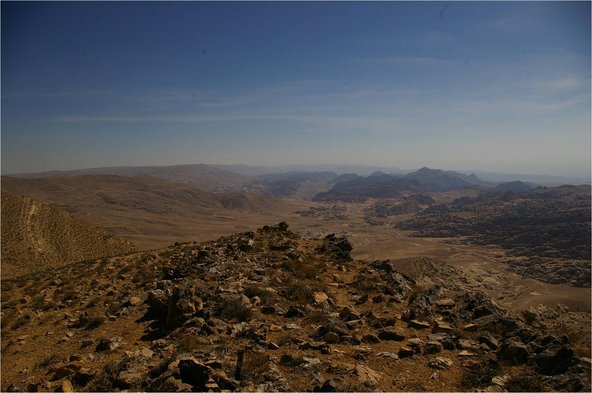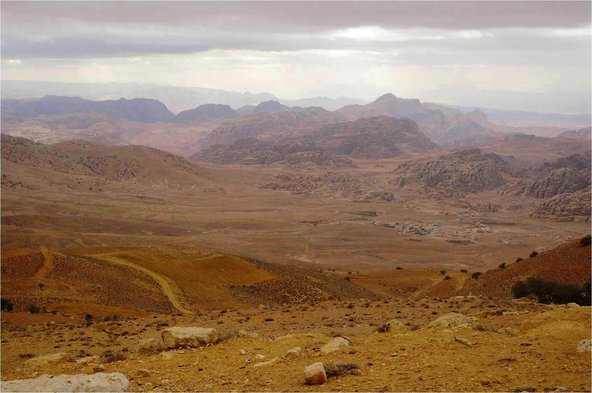Did Petra's inhabitants really abandon the city?
by Dr Micaela Sinibaldi
6 Mar 2018
In the first episode of the BBC Two series, Civilisations, Simon Schama FBA explored the ancient city of Petra where he showed the complex water systems engineered by the Nabataeans that helped turn Petra into a flourishing “garden city”. We saw its rise due to the incense trade and then its decline when new trade routes made Petra commercially irrelevant. But where did Petra’s inhabitants go, and did they really abandon the city?

Petra (in the foreground) and the city of Wadi Musa (in the background) on the slopes of the Shara Mountains (from South-West). Photo: Micaela Sinibald
The Nabataeans’ masterful management of water
The city of Petra in the Nabataean period existed thanks to the masterful water management by the Nabataeans, who were clearly very proud of it. A sophisticated hydraulic system disciplined, collected and brought water in the valley for the use of tens of thousands of people. One of the most important parts of this system was diverting the entrance of rain water, which would naturally flow through the Siq, bringing it to the city centre for the people's use and therefore allowing them to use the Siq as an entrance to the city at any time. Today, because the system is in disrepair, the Siq still gets occasionally heavily flooded.
The widely accepted notion of the “abandonment” of Petra
The commonly accepted narrative, even by some scholarly views, has maintained that when the role of Petra changed along with broader socio-economic dynamics, the city was completely abandoned and it remains completely silent about Petra’s history following this moment until Burckhardt rediscovered it to the West in 1812 . The only episode breaking this long period of abandonment in the narrative is the 50-60 year Crusader period in Petra (1130/40-1188), often mentioned as a period of revival, which is still witnessed by several castles.
The Frankish settlement in the Crusader period
In the Crusader period, the Franks were attracted to the Petra area both by its fertility and the large presence of Christians, whom they felt were essential to find support for their economic control of the area. Their local economy was mainly based on agriculture and in the Petra region they founded and controlled castles and villages.

Al-Wu'ayra, a Crusader Castle just outside the Petra valley. Photo: Micaela Sinibaldi
However, it is clear from both documentary and archaeological sources that the Franks simply introduced themselves in an already burgeoning economy, based on the long-established agriculture of these fertile areas. Even though Petra was prosperous, it was quite simply rarely mentioned in the historical sources after the Byzantine period because it just was a provincial town.
A different picture for the post-urban life of Petra
My recent research on the entire Islamic period in Petra, including the Crusader-period, has proven that the dramatic picture of complete abandonment of the region of Petra is erroneous, and that it was possible to reconstruct, on the basis of the first in-depth research on all the available historical and archaeological sources, a different picture for the page of history of the post-urban life of Petra. These conclusions were the result of the study of local ceramics and building styles from many archaeological excavations and surveys, which allowed me to start assigning dates to the large quantity of ceramics found in and outside the Petra valley.
The gradual move to nearby fertile areas
After the sophisticated hydraulic system slowly fell into disrepair, most inhabitants of the Petra valley gradually, but not completely, moved to the nearby fertile areas where they could find better opportunities for water and agriculture. They continued to practice agriculture in several of the fertile areas under the Shara mountains, some of which were already intensely inhabited during the Nabataean period such as Wadi Musa, where agriculture is still practiced today.

Petra seen from the top of the Shara Mountains (from North). Photo: Micaela Sinibaldi
Archaeological evidence of Petra’s continued life and prosperity throughout the Islamic period
From the Islamic period ceramics that I have analysed, it is clear that some people have always inhabited the Petra valley. They mainly lived in the now emptied Nabataean rock-carved structures, which were certainly better insulated than houses, and probably practiced agriculture on small terraces inside the valley.

Petra seen from the top of the Shara Mountains (from North), with the slopes of the mountains in the foreground, the fertile Bayda plains at the centre, and the Petra mountains in the background. Photo: Micaela Sinibaldi
Just a short distance from the valley, this agriculturally-based life continued without any significant gaps, as clearly proven by excavations in the city of Wadi Musa where an uninterrupted sequence of occupation witnesses the agricultural prosperity of the area and settlement throughout the whole Islamic period. The Islamic Bayda Project, the archaeological project I direct in Petra, studies the site which holds the most extensive, accessible archaeological evidence for the Islamic period in the Petra region. Here, we are documenting a large agricultural village which includes two mosques, the first to ever have been excavated in the Petra region.
“Just a short distance from the valley, this agriculturally-based life continued without any significant gaps, as clearly proven by excavations in the city of Wadi Musa”
Why is there a misunderstanding of Petra’s abandonment?
The big misunderstanding, which traditionally saw Petra as a completely abandoned city after the Byzantine period, derived from several elements: the traditional focus of archaeologists on the exceptional remains in the Petra valley and less attention to its hinterland and its relationship with the valley itself; the great importance of the Nabataean period in the area, as opposed to the ones which followed; the difficulty of the interpretation of the archaeological documents involved, especially ceramics; and last but not the least, a certain fascination of seeing Petra in the dramatic, black-and-white tones of a complete abandonment and sudden rediscovery, cultivated by a somewhat Orientalist taste.
In summary, the unique, exceptional archaeology in the Petra valley in the Nabataean period has resulted in obscuring the graduality of changes and the aspects of continuity in settlement patterns which normally characterise history much more often than aspects of disruption and sudden, abrupt changes.
Dr. Micaela Sinibaldi is Honorary Research Fellow at Cardiff University and currently acting Deputy Director of the Council for British Research in the Levant's (CBRL)’s Kenyon Institute in Jerusalem. The conclusions presented here are from her study of the Petra region in the later periods, called The Late Petra Project, of which the Islamic Bayda Project is an integral part. The Late Petra Project,which is based on the results of a PhD thesis defended at Cardiff University on the Subject of Jordan in the Crusader period, has been supported, among others, by funds of the British Academy through a Visiting Research Fellowship at the CBRL's institute in Amman, the BIA.
Parts of the conclusions of the project on Petra during the Crusader period have been published in the volume Crusader Landscapes, a collection of 27 essays on recent historical and archaeological research on the Crusader period, which was co-edited by Dr. Sinibaldi; the production of the book and its four launches have been generously supported, among others, by the CBRL British Academy.
Image credits:
Photos by Micaela Sinibaldi
Twitter card: istock.com/prasit_chansareekorn


